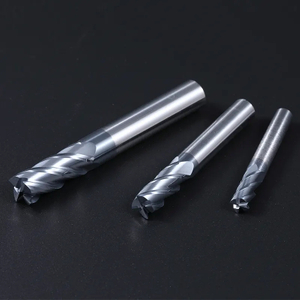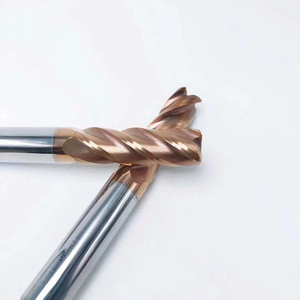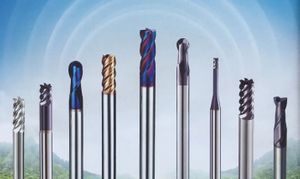A Detailed Guide to Choosing the Perfect 4mm Ball Nose End Mill
Machining and milling operations are only successful when the correct tools are put into action. Among these cutting tools, the 4mm ball nose end mill stands out for its variety of uses and capability to generate delicately curved surfaces. This article will explore the considerations required when selecting this particular end mill, enabling you to make decisions that will result in the best possible outcomes.
Ensure that the components you choose are suitable for your application requirements. Choosing the appropriate material is important to the successful operation of any product. It is worth considering the risks associated with making an inappropriate choice. Consider both physical and chemical properties when selecting a material for optimal performance and compatibility.

Are you in the market for a 4mm ball nose end mill, but don't know where to start? The material you plan to work with should determine your decision-making process. Let's take a look at how specific cutting tools can make the job easier. If your focus is on metals, then opt for an end mill crafted out of carbide - this material can handle the high temperatures and remain durable. If your trade is working with wood, then a ball nose end mill with a sharper edge and additional blades is a more suitable option. With the right selection, machining will be efficiently handled.
When utilizing a machine tool, it is vital to optimize speed and feed rate for precise cutting. Sufficient planning and precision must be taken to ensure the accuracy of the desired outcome; crafting quality cuts with an effective speed and feed rate is essential.
When it comes to machining, the cutting speed and feed rate are two critical elements to be aware of when working with a ball nose end mill. Depending on the material being machined, the desired finish, as well as the capabilities of the machine, these parameters can drastically vary. While higher cuts and feed rates usually come with a sleeker output and greater efficiency, they also call for sturdier setups with enough strength to take on the resulting forces. Before engaging in any projects, it's highly recommended to consult manufacturers' specifications and handbooks for compatibility and maximal results.
It is important to adhere to key features such as counting the flutes and measuring the helix angle for successful results. Strict adherence to specific guidelines for these elements is necessary for optimal outcome.
Choosing an end mill with the most suitable flute count and helix angle is critical to achieving optimal machining outcomes. Increasing the tool's flutes result in better chip evacuation, avoiding the recutting of chips and enabling a smoother operation. Nevertheless, it is necessary to guarantee adequate chip space for displacement due to its larger number of flutes. Additionally, the helix angle decides the direction along which the flutes spiral on the tool. A sharper angle boosts shearing action and reduces vibrations, ultimately leading to higher cutting capabilities. Finding balance between these components is indispensable for successful performance.
To ensure optimal tool life and satisfactory coating, following specific rules is essential. When it comes to tool longevity and reliable coating, vigilance in following instructions is of utmost importance. Taking the necessary precautions for successful surface covering and long-lasting tool performance guarantees superior results.
To ensure your 4mm ball nose end mills perform better and last longer, the use of tool coatings such as Titanium Nitride (TiN), Titanium Carbonitride (TiCN), and Titanium Aluminum Nitride (TiAlN) can be the difference-maker. These coatings can increase wear resistance, reduce friction, and stabilize temperatures during machining, making it crucial to select the coating variant which is ideal for your specific application.
The right 4mm ball nose end mill may be more than just its cutting tool's diameter. When seeking the ideal one, it's important to consider various factors, including material compatibility, cutting speed, feed rate, flute count, helix angle and coating properties. Thorough exploration, advice from professionals and experimentation can bring excellent results and allow you to pick the perfect ball nose end mill as per your needs. Understanding and assessing the mentioned elements can further boost accuracy and efficiency of your machining tasks.
Discover the tricks to selecting the ideal 4mm Ball Nose End Mill! Whether you’re a pro in the manufacturing sector or a DIY enthusiast, make sure to arm yourself with expert tips for smoothly navigating your options for this cutting tool.
If you are looking for the right cutting tool for your milling project, the 4mm ball nose end mill is an ideal option due to its precision and versatility. To make the best choice and get the best outcomes for your machining applications, it's important to consider all the essential factors when selecting a 4mm ball nose end mill. In this article, we'll provide you with the key knowledge to assist you in making an informed decision and unlock your milling potential.
1. Compatibility with Materials: Ensure that all materials used are up to par and suitable for the job. Keeping a close eye on the standards of the materials can help guarantee successful results.
For same superior results for your machining projects, it is important to evaluate the material beforehand. Different substances like wood, metal, or plastic require specific tools and specifications to ensure quality results. Assess the hardness, brittleness as well as the density of the material before settling on a 4mm ball nose end mill. To be certain that you get the right cutting tool for your project, consider consulting a specialist or refer to material-specific machining guides.
Complying with the rules is an absolute must. Keeping track of flutes is essential as any kind of discrepancy can have long-term consequences. To ensure that everything runs smoothly, a proper flute count must be conducted and monitored regularly. Doing this will help ensure accuracy and efficiency while avoiding potential problems down the line.
The fluting choices on a 4mm ball nose end mill can make a significant difference in your project's cutting power and finished product. Two- and four-flute options are the most typical, with the two-flute end mill recommended for general-purpose tasks needing a faster chip removal rate. If smoothness is key for a difficult job, then consider the four-flute design. Keep your specific project goals in mind when selecting the right fluting count.

When choosing a coating for your project, it is essential to take into consideration a variety of different factors. This may include environmental conditions, the desired level of protection or resistance, and also the cost and availability of the product. Therefore, proper research and analysis should be completed to ensure you pick the coating that will best suit the needs of your particular project.
The kind of coating on a 4mm ball nose end mill can make a major difference when it comes to its durability and efficiency. Selecting the appropriate covering can reduce frictional drag, boost wear resistance, and prevent chip accumulation. Popular options consist of titanium nitride (TiN), titanium carbonitride (TiCN), and aluminum titanium nitride (AlTiN). Every choice typically has a unique benefit in addition to certain drawbacks, so you should think about the machining circumstances, material being processed, as well as desired tool life before deciding.
Achieving optimal performance when machining requires focusing on two key factors: cutting speed and feed rate. These two elements require attentive adjustment to obtain maximum output and accuracy in the finished product.
Achieving optimal milling results requires an understanding of the correlation between cutting speed and feed rate. Cutting speed indicates how fast the 4mm ball nose end mill rotates, while feed rate shows the speed at which it advances into the material. Striking a balance between the two determines effective chip removal and minimizes wear on the tool. Within manufacturer suggestions, you can test different speeds and feeds to find your ideal combination for whatever application you're using.
When utilizing tools, life expectancy and cost should be taken into account. These considerations are important for optimizing the return on investment with every job.
When selecting a 4mm ball nose end mill, tool life and cost are major considerations. Though carbide tools tend to last longer than HSS, they typically cost more. Consider the importance of an extended tool life for your project, and compare it to the cost of the associated tools. Moreover, if you are expecting to perform high-volume milling operations, think about the option for regrinding existing tools and the availability of alternative replacements.
When it comes to selecting the appropriate 4mm ball nose end mill, you should take various factors into account. Material compatibility, flute count, coating selection, and cutting speed and feed rate all play a role in your success. Additionally, tool life and cost are essential components in making the right decision. Don't forget to look into manufacturers' recommendations and utilize knowledgeable advice if needed. Above all else, prioritizes premium quality for maximum milling precision, productivity, and excellent results.







